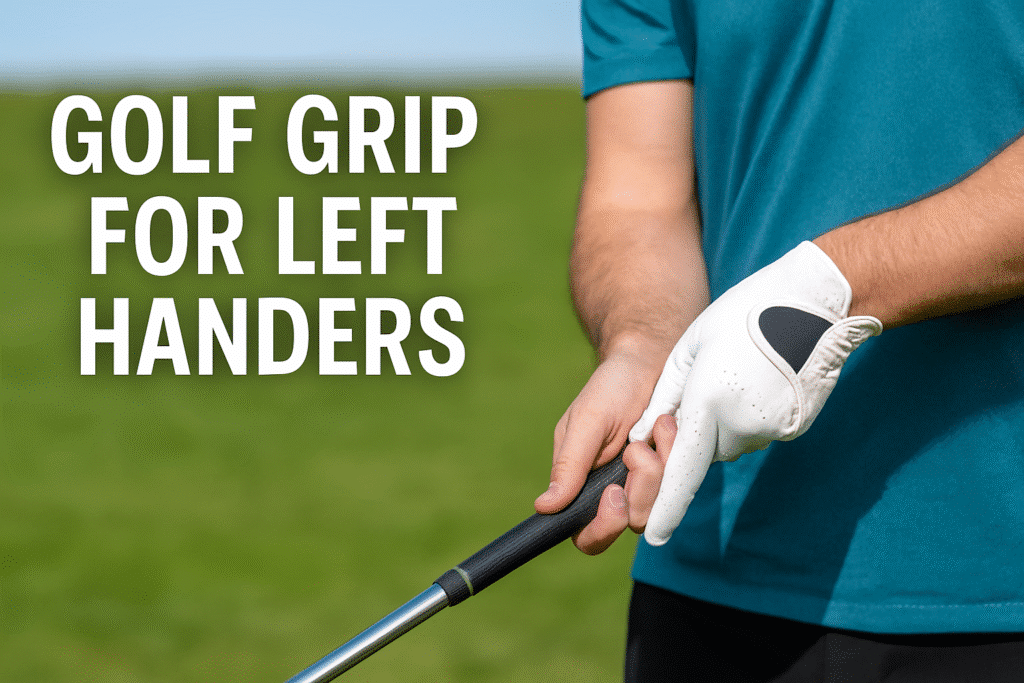Golf Grip for Left Handers: Master Your Left-Handed Swing
A lefty-friendly guide to the golf grip for left handers. Learn easy grip steps, tips for beginners, intermediate and advanced players, plus gear reviews. Golf Grip for Left Handers: Complete Guidelines for Everyone Golf is a game of precision, and every player needs a solid grip – lefties included. Left-handed players have unique challenges, from finding gear to mirror-imaging right-handed lessons. In this guide on golf grip for left handers, we cover everything: step-by-step grips for beginners, adjustments for intermediate players, and pro-level techniques. New players will learn how even a simple change in your club hold leads to big improvements – getting comfortable with the golf grip for left handers sets a strong foundation. You’ll also find top gloves, training aids, and clubs reviewed. Let’s tee off and get your left-handed grip dialed in! Why Grip Matters for Left-Handers A strong, neutral grip helps every golfer hit straighter, more consistent shots. If your grip is too weak, you’ll struggle with slices (ball curving right for lefties). If it’s too strong, you may hook the ball left. The key is balance. For lefties, get your hands in a neutral position on the club so you can swing freely each time. Lefty pro Phil Mickelson knows this well – he holds the club with a powerful yet relaxed grip, keeping his clubface square to the target. How to Grip a Golf Club Left-Handed (Beginner) Mastering the left-handed grip starts with the right hand (your lead hand). Follow these easy steps: Place Your Right Hand First For lefties, your right hand goes on the grip first. Run the club handle diagonally across the base of your right fingers, from the top knuckle of your index finger down toward your pinky. Close your right hand so it feels like a handshake with the club – the grip sits in your fingers, and the thumb pad rests on it. This right-hand lead is the foundation of a proper golf grip for left handers. Add Your Left Hand Next, set your left hand (trail hand) below the right on the grip. Again, align the club diagonally across the left fingers. Both thumbs should point down the shaft along the target line. Your left thumb should rest on top of the grip, creating a “V” shape with your left index finger. This V should point to your right shoulder. Grip Style Choices Beginners often use the ten-finger (baseball) grip, where all 10 fingers hold the club. This feels natural (like holding a bat) and is great for power. As you improve, try the interlocking grip (hook left pinkie into right index for more control) or the overlapping grip (right pinkie over left index) to make your hands act as one. Thumb Placement After both hands are on the club, ensure both thumbs point down the shaft. The Vs formed by your thumbs and index fingers should aim toward your right shoulder – this shows a neutral grip. Grip Pressure Hold the club firmly but not too tight. The tension should be enough to control the club without “white knuckles.” A relaxed grip lets your wrists hinge freely for a smooth swing. Tip: Imagine you’re holding a small bird. Your grip should be gentle, so you don’t crush it, but secure enough so it won’t fly away. A classic golf illustration showing the swing of a golfer (Chick Evans, 1921). Notice how the hands and club move together – a result of a consistent grip. Best Golf Grip for Left Handers There isn’t one single grip that works for all lefties. Most beginners start with the baseball grip (all 10 fingers on the club) because it feels natural. As your game improves, you might switch to interlocking or overlapping grips for more control. Best golf grip for left handers is the one you can hold comfortably while keeping the clubface square at impact. Grip Styles for Different Levels Lefties can experiment with grip styles as they improve. Each style has pros: As you progress, try different grips on practice swings to see what feels best. For example, start with ten-finger as a beginner and later use overlap for more distance and shot control. Beginner to Advanced Grip Techniques Beginner Methods Start simple. Use the ten-finger grip and focus on swinging smoothly. Put your hands on the club as above and swing slowly at first. At first, just hitting the ball straight is a win. Keep your right (lead) hand firm and let your left hand provide support. Always hold the club in the fingers (not the palm) – this gives better control. Intermediate Tips Once you can hit the ball consistently, work on finer points: Advanced Techniques Skilled lefties fine-tune their grip for shot shaping: Equipment for Left-Handed Golfers Finding left-handed gear can be tricky, but many good options exist: Left-Handed Gloves Lefties wear a glove on their right hand. Quality gloves improve feel and prevent slipping. For example: Grip Training Aids Special tools can reinforce a proper left-handed grip: Clubs and Grips Make sure you have lefty clubs from a reputable brand. When buying clubs, check that “LH” (left-handed) is specified. Also consider the grips on your clubs:Changing grips on your irons or driver for a more comfortable texture can make a subtle difference in control. For lefties, a thicker or softer grip might reduce wrist movement; thinner grips can give more feel. Notice the clubface orientation – left-handed irons look like mirror images of righty clubs. Choosing the right clubs and grips is crucial for left-handed players. Top Left-Handed Golf Grip Products (Reviews & Comparison) We tested and reviewed some popular gear to help lefties improve their grip. Here’s a quick look: Product Type Key Features Callaway Tour Authentic Glove (Left) Glove Premium Cabretta leather, infused with “Griptac” for tackiness. Trusted by pros for fit and durability. FootJoy WeatherSof Glove (Left) Glove Synthetic leather, soft feel and water resistance. Comfortable in heat. Stretch panels for perfect fit. ProActive Sports Retractable Trainer (Left) Swing Trainer
Golf Grip for Left Handers: Master Your Left-Handed Swing Read More »



